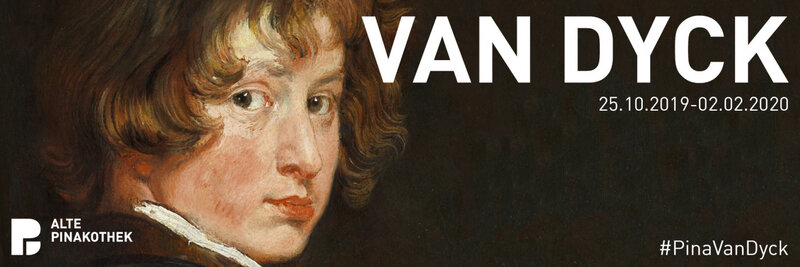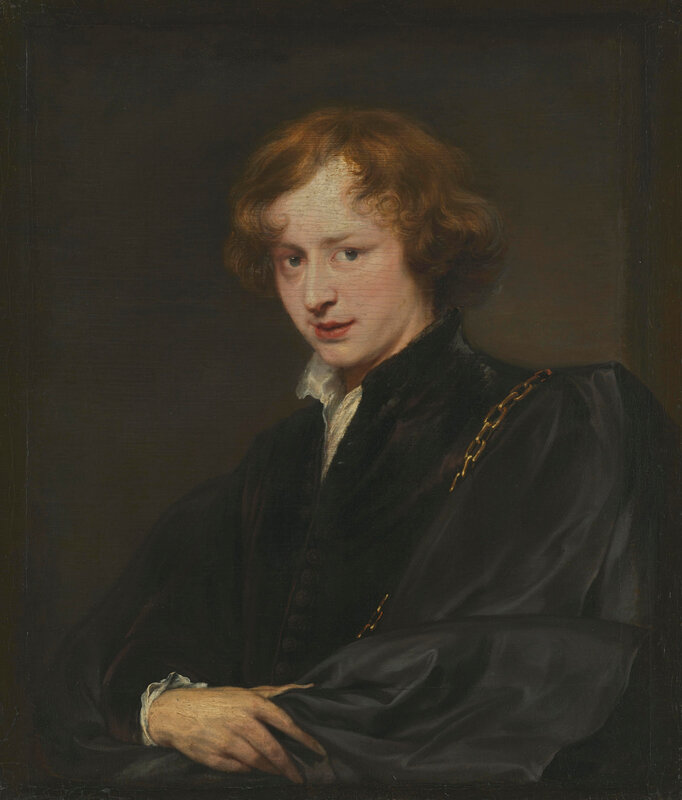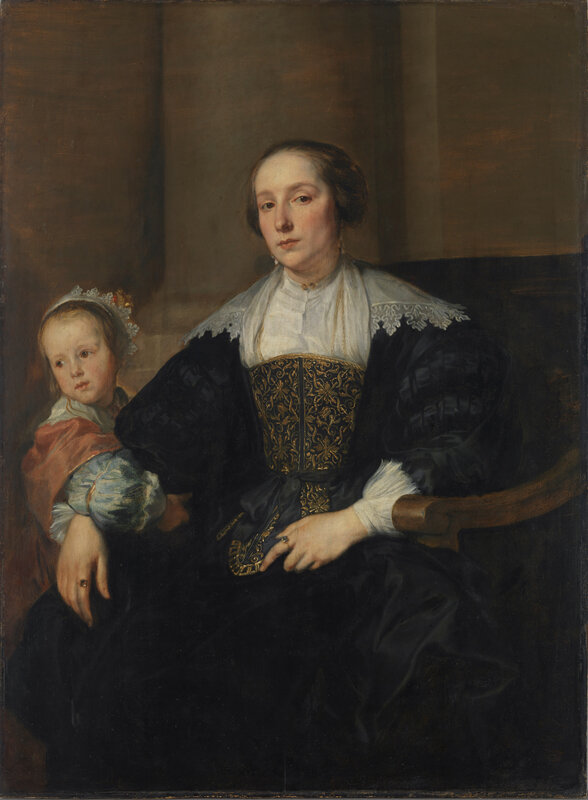Exhibition at Alte Pinakothek traces Anthony Van Dyck's development as an artist
MUNICH.- Anthony van Dyck – celebrated across Europe for his portraits of the rulers, military commanders, artists, and beauties of his age. He captured his subjects with unparalleled vitality while also clearly denoting their status. Yet Van Dyck’s path to fame was no easy one: the early years of his career were overshadowed by the famous Peter Paul Rubens: the role model, as much admired as he was unassailable, whose influence is most palpable in Van Dyck’s early history paintings. It was only in Italy and through the close study of Venetian painting – of Titian and Tintoretto – that Van Dyck came to find his own style.
The exhibition allows the visitor to get close to an artist who was always probing – wrestling with his own creativity and painterly goals. Van Dyck’s profound study of artistic role models ultimately saw him shift from history painting to portraiture, a genre that he made his own, rising to become one of the best-known and most sought-after painters of his age. He responded to this high demand by adopting efficient production methods and by ruling over a workshop of many assistants, each set a clearly defined task, so much so that he stands before us not only as Van Dyck the artist, but also, in a certain sense, as Van Dyck the entrepreneurial manager.
Anthony van Dyck (1599-1641), Self portrait, c. 1615. Oil on wood (oak), 43 x 32.5 cm © Vienna, Picture Gallery of the Academy of Fine Arts
The insights into the artist’s life and work presented here draw on the results of several years’ research on the Van Dyck collection in Munich, in a scholarly project that preceded today’s exhibition. Its aim was to arrive at a more precise chronology of the paintings, to trace the evolution of the master’s personal style, and thus to derive criteria to distinguish between autograph works and those by the workshop. With the help of X-radiographs and infrared reflectograms (also on display in the exhibition), it is possible to trace how Van Dyck developed, discarded, and reworked his compositions, especially in the early history paintings, before finally arriving at an image that suited his conceptions. At the same time, the insights into the pictures’ genesis and the applied working methods shed light on one of the most productive artist’s workshops of the 17th century.
Featuring some 100 exhibits, among them numerous stellar loans from museums and private collections from across Europe and the USA, the show traces Van Dyck’s development as an artist. The first section is devoted to his early works. These are mainly religious and mythological paintings that display a clear indebtedness to Rubens. Characteristic of this period is the complex genesis of each work, as illustrated in the exhibition by the study drawings and sketches that went into each canvas’ making.
Anthony van Dyck, Self-portrait, c. 1620/21. Oil on canvas, 119.7 × 87.9 cm © New York, lent by the Metropolitan Museum of Art, The Jules Bache Collection, 1949
Opening the fourth chapter are ten grisaille oil sketches from the collection of the Alte Pinakothek, which were made as part of Van Dyck’s mammoth printmaking project, the ‘Iconography’: they reflect the work processes within the workshop, from the master’s own designs to the printmakers’ final execution in copperplate or etching. Both subsequent reproductive prints and the numerous copies made by his own specially qualified workshop assistants were instrumental in disseminating Van Dyck’s art, heightening his fame and securing his place in the history of art.
Alte Pinakothek - 25.10.2019 ‐ 02.02.2020
Anthony van Dyck, Self-Portrait, c. 1620/21 and 1627. Oil on canvas, 81.5 x 69.5 cm © Bayerische Staatsgemäldesammlungen, Alte Pinakothek, Munich
Anthony van Dyck, Drunken Silenus, c. 1617/18. Oil on canvas, 107 × 91.5 cm © Berlin, bpk - Picture Agency for Art, Culture and History / Staatliche Kunstsammlungen Dresden, Old Master Paintings Gallery / Elke Estel / Hans-Peter Klut.
Peter Paul Rubens, Drunken Silenus, c. 1617/18, additions c. 1625. Oil on wood, 212 × 214.5 cm (total) © Bayerische Staatsgemäldesammlungen, Alte Pinakothek, Munich.
Anthony van Dyck (1599-1641), Susanna and the and the Elders, c. 1621/22. Oil on canvas, 194 x 144 cm © Bayerische Staatsgemäldesammlungen, Alte Pinakothek, Munich.
Anthony van Dyck, The holy family in a landscape, c. 1630. Oil on canvas, 134.7 x 114.8 cm © Bayerische Staatsgemäldesammlungen, Alte Pinakothek, Munich.
Titian, The Virgin and Child at an evening landscape, c. 1560. Oil on canvas, 173.5 × 132.7 cm © Bayerische Staatsgemäldesammlungen, Alte Pinakothek, Munich.
Anthony van Dyck, Sebilla vanden Berghe, c. 1630. Oil on canvas, 210.5 x 136.7 cm © Bayerische Staatsgemäldesammlungen, Alte Pinakothek, Munich.
Anthony van Dyck, Filips Godines, c. 1630. Oil on canvas, 211.5 x 137.5 cm © Bayerische Staatsgemäldesammlungen, Alte Pinakothek, Munich.
Anthony van Dyck, The painter Theodoor Rombouts, c. 1631/32. Oil on wood (oak), 122.9 x 90.8 cm, Bavarian State Painting Collections , Alte Pinakothek, Munich.
Anthony van Dyck, Susanna Fourment with Her Daughter Clara del Monte, 1621. Oil on canvas, 172 x 117 cm © National Gallery of Art, Andrew W. Mellon Collection, Washington, DC
Anthony van Dyck, The Engraver Karel van Mallery, c. 1630‒1635. Oil on canvas, 99.5 x 84 cm © The National Museum of Art, Architecture and Design, Oslo.
Anthony van Dyck, Anna Thielen with her daughter Anna Maria Rombouts, c. 1631/32. Oil on Wood, 122.8 x 90.7 cm © Bayerische Staatsgemäldesammlungen, Alte Pinakothek, Munich.
Anthony van Dyck, Two Studies of a Bearded Man, c. 1616/17. Oil on paper, canvas and wood, 40.5 x 53.5 cm © KBC Art Collection Belgium, Museum Snijders & Rockox House, Antwerp.
Anthony van Dyck (workshop), Lucas van Uden, c. 1629-1634. Oil on Wood, 24.4 x 20.5 cm © Bayerische Staatsgemäldesammlungen, Staatsgalerie Neuburg.
Anthony van Dyck, Lucas van Uden, c. 1629-1635. Black chalk on paper, 252 x 162 mm © Rijksmuseum, Amsterdam.
Lucas Vorsterman (after Anthony Van Dyck), Lucas van Uden, 2nd State. Engraving, 257 x 161 mm © Rijksmuseum, Amsterdam.
Anthony van Dyck, George Gage with Two Attendants, c. 1622/23. Oil on canvas, 115 x 113.5 cm © The National Gallery, London

/https%3A%2F%2Fprofilepics.canalblog.com%2Fprofilepics%2F1%2F0%2F100183.jpg)
/https%3A%2F%2Fstorage.canalblog.com%2F03%2F02%2F119589%2F96711876_o.jpg)
/https%3A%2F%2Fstorage.canalblog.com%2F11%2F31%2F119589%2F94773502_o.jpg)
/https%3A%2F%2Fstorage.canalblog.com%2F20%2F83%2F119589%2F94772815_o.jpg)
/https%3A%2F%2Fstorage.canalblog.com%2F26%2F72%2F119589%2F75604929_o.jpg)
/https%3A%2F%2Fstorage.canalblog.com%2F59%2F60%2F119589%2F26458628_o.jpg)






















/image%2F1371349%2F20240322%2Fob_e601c4_1-bruegel-temptation-of-st-anthony.jpg)
/http%3A%2F%2Fstorage.canalblog.com%2F99%2F21%2F119589%2F129271593_o.jpg)
/http%3A%2F%2Fstorage.canalblog.com%2F68%2F37%2F119589%2F128313729_o.jpg)
/http%3A%2F%2Fstorage.canalblog.com%2F35%2F62%2F119589%2F127009882_o.jpg)